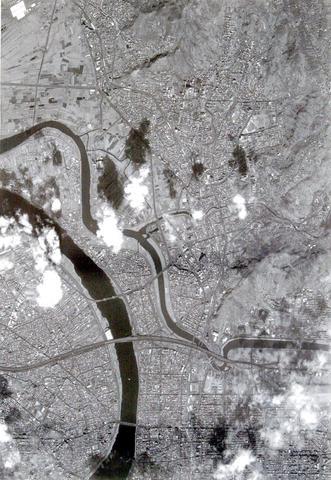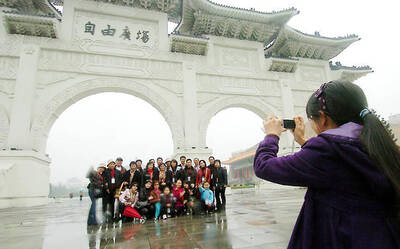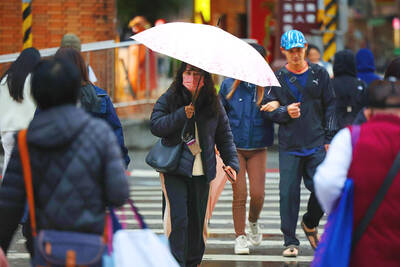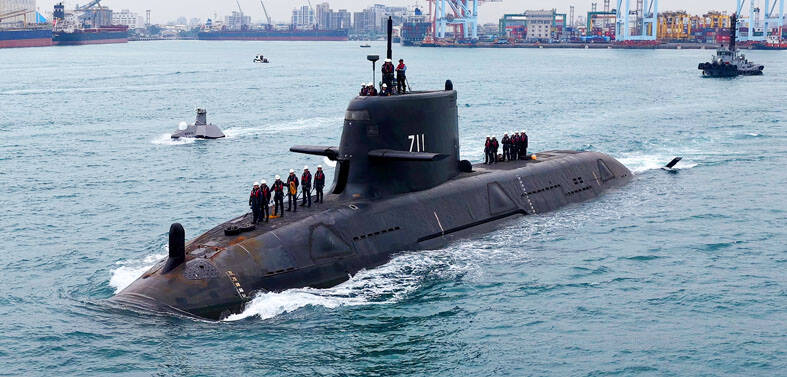When the eighth-century poet Wang Chih-huan (王之渙) wrote the famous lines, "If more distant views are what you desire, simply climb a storey higher (欲窮千里目, 更上一層樓)," he was not likely imagining that people 13 centuries later would follow the spirit of his words by launching satellites into space.
Wang's lines were used by President Chen Shui-bian (陳水扁) on Friday as part of the congratulatory address he delivered to the team responsible for the launch of the nation's second satellite, ROCSAT-2.

PHOTO: QUICK BIRD SATELLITE IMAGE, NATIONAL SPACE PROGRAM OFFICE
"In addition to broadening our ability to observe not only Taiwan but also the rest of the world, ROCSAT-2 increases our scientific knowledge," Chen said as he started, by remote link, ROCSAT-2's digital signal processor.
Chen was speaking at the Presidential Office, where a launch ceremony was being held simultaneously with a ceremony that was taking place at the National Space Program Office (NSPO) in Hsinchu.
Capable of producing images of objects as small as 2m across, and with its orbit set so that it can pass over Taiwan twice daily, ROCSAT-2 will provide timely and useful images of sites all over the nation.
"The satellite will provide useful applications for fields including utilities, agricultural and forestry planning, environmental monitoring, natural disaster evaluation and scientific research," NSPO Director Lee Luo-chuan (
The satellite is orbiting the planet 14 times a day and passes over the middle of the Taiwan Strait twice a day. The first daily pass-over of Taiwan, at 10:00am, allows eight minutes of imaging time. The second visit, at 10:00pm, is used to download to earth the data accumulated on board the craft.
Military purposes?
According to Lee, the satellite can provide imaging of the entire island of Taiwan by producing just four neighboring image strips -- assuming that the weather co-operates.
Also, through elevation-angle maneuvering, three-dimensional imaging data can be produced.
Lee said that the satellite can take photos of almost any spot on the globe and has great promise as a commercial supplier of satellite images.
"Marine pollution, coastal smuggling and other applications -- you name it," Lee said.
Although some have wondered whether the satellite could be used for military purposes, NSPO officials maintain that ROCSAT-2 was designed only for civilian purposes.
In the past, Taiwan has been one of the world's biggest buyers of satellite information. Each year the government and private research institutions spend large amounts of money on satellite data -- data covering topics from climate to topography.
"Because of ROCSAT-2, Taiwan can now become a satellite image exporter," Lee said.
According to the NSPO, two research institutes in Japan have asked about purchasing ROCSAT-2's images. Acquiring up-to-date satellite images of the areas near Japan -- including North Korea -- became an urgent need for Japan after two recent satellite projects failed, officials said.
Better clarity
NSC Deputy Minister Shieh Ching-jyh (
"Importantly, Taiwan can operate the satellite independently for various purposes," Shieh said.
Chen Shao-hsing (
Also expressing interest so far in purchasing images are world-class commercial satellite-image suppliers such as QuickBird, Space Imaging's IKONOS and SPOT.
Citing as examples high-resolution QuickBird images of Kaohsiung Harbor and Taipei City, Chen said the unit price for such images exceeds NT$360,000.
"In the future, ROCSAT-2 will produce similar but even more valuable images due to the better clarity we will be able to achieve," Chen said.
Meanwhile, the NSPO's Image Processing System (IPS), an integrated hardware and software system that handles remote-sensing image data, has generated interest among universities engaged in disaster prevention and geographic research.
Last August, NSPO demonstrated the capabilities of IPS, which can receive and generate remote-sensing image data from satellites. To date, 10 research units from various universities have placed orders for the machine, whose unit price is NT$5 million.
"Taiwanese businesses engaged in image-processing might also get a boost from the availability of clear satellite images from ROCSAT-2," Chen Shao-hsing said.
Wei Che-ho (
The satellite, costing NT$4.7 billion, was designed and built by the NSPO in collaboration with Astrium Co of France.
After the project got under way in 2000, Astrium chose six Taiwanese companies as sub-contractors: Acer Sertek, which manufactured ROCSAT-2's on-board management unit; Tatuing System Technology, which developed the craft's on-board flight software module; Shihlin Electric and Engineering, which manufactured the sun sensor; Victory Industrial, which produced S-band antennas; Aerospace Industrial Development, which manufactured the flight harness; and Taiwan Aerospace, which designed and manufactured the vertical installation dolly.
Lightning
"We hope that domestic firms will be able to replace foreign companies and become major contractors for satellite projects," Wei said.
In addition, NSC officials said that ROCSAT-2 would make the nation a potential leader in the hot field of upper-atmospheric lightning research. This type of lightning -- characterized by rarely-observed transient luminous events -- is split up into three categories: lighting-induced red sprites, upwardly discharging blue jets and gigantic jets.
Wu Maw-kuen (吳茂昆), new council minister, said ROCSAT-2 would increase the value of existing research in lightning-related fields.
"ROCSAT-2 will be the first satellite to observe these phenomena from space," Wu said.
Red sprites were not observed by scientists until 1989. The discovery triggered a series of observations leading to the discovery of blue jets and gigantic jets in the 1990s.
In May 2001, a team composed of scientists from National Cheng Kung University -- scientists who were involved in the ROCSAT-2 project -- used a CCD camera at A-Li Mountain (阿里山) to record images of red sprites occurring above China's Guangdong Province.
On July 22, 2002, the team recorded five gigantic jets over the southern tip of Taiwan.
The upper bodies of the gigantic jets, which were observed for just 800 milliseconds, were similar to those of red sprites, but their lower bodies resembled those of blue jets.
The observations were published in the world-class science journal Nature in June of last year.
To mark the success of ROCSAT-2's liftoff, the researchers published on their Web site photos of red sprites taken on May 13.
Higher orbit
Following ROCSAT-2's liftoff, engineers at the Mission Operation Center (MOC) at the NSPO's headquarters in Hsinchu are spending 10 to 14 days transferring the satellite from a temporary orbit to a higher one -- at 891km.
The software that the MOC uses was developed by Integral Systems, a US company that builds ground systems for satellites. Integral's biggest customer is the US Air Force, which operates about 60 satellites.
Chen Yen-wu (
NSPO officials said that technology transfers involving ROCSAT-2 have aided in the development of the nation's scientists. During the life of the ROCSAT-2 project, Integral Systems has transferred to local engineers and scientists technology related to controlling satellites, processing payload data and other areas.
"Like my colleagues, I'm proud to have received information from ROCSAT-2 earlier than other people. It's quite an exciting national project," Charlie Liao (

NUMBERS IMBALANCE: More than 4 million Taiwanese have visited China this year, while only about half a million Chinese have visited here Beijing has yet to respond to Taiwan’s requests for negotiation over matters related to the recovery of cross-strait tourism, the Tourism Administration said yesterday. Taiwan’s tourism authority issued the statement after Chinese-language daily the China Times reported yesterday that the government’s policy of banning group tours to China does not stop Taiwanese from visiting the country. As of October, more than 4.2 million had traveled to China this year, exceeding last year. Beijing estimated the number of Taiwanese tourists in China could reach 4.5 million this year. By contrast, only 500,000 Chinese tourists are expected in Taiwan, the report said. The report

Temperatures are forecast to drop steadily as a continental cold air mass moves across Taiwan, with some areas also likely to see heavy rainfall, the Central Weather Administration (CWA) said. From today through early tomorrow, a cold air mass would keep temperatures low across central and northern Taiwan, and the eastern half of Taiwan proper, with isolated brief showers forecast along Keelung’s north coast, Taipei and New Taipei City’s mountainous areas and eastern Taiwan, it said. Lows of 11°C to 15°C are forecast in central and northern Taiwan, Yilan County, and the outlying Kinmen and Lienchiang (Matsu) counties, and 14°C to 17°C

STEERING FAILURE: The first boat of its class is experiencing teething issues as it readies for acceptance by the navy, according to a recent story about rudder failure The Hai Kun (海鯤), the nation’s first locally built submarine, allegedly suffered a total failure of stern hydraulic systems during the second round of sea acceptance trials on June 26, and sailors were forced to manually operate the X-rudder to turn the submarine and return to port, news Web site Mirror Daily reported yesterday. The report said that tugboats following the Hai Kun assisted the submarine in avoiding collisions with other ships due to the X-rudder malfunctioning. At the time of the report, the submarine had completed its trials and was scheduled to begin diving and surfacing tests in shallow areas. The X-rudder,

DEMAND: The government should enact regulations in line with Austria and Germany to incorporate vegan nutrition into school meals, an advocate said More than 1,000 people yesterday marched in Taipei to promote veganism, calling for legislation to incorporate vegan diets into school lunches and the national net zero emissions program. Participants gathered on Ketagalan Boulevard in front of the Presidential Office Building for the march, which was organized by the Vegan Action Network (VAN). Former ambassador to Chad Chiu Chung-jen (邱仲仁), actor Yankee Yang (楊子儀) and actress Cindy Lien (連俞涵) attended the event. VAN member Marianne Chao (趙梅君) said that the campaign aimed to urge the government to promote vegan diets across schools and government agencies via legislation and national policies, which would help build